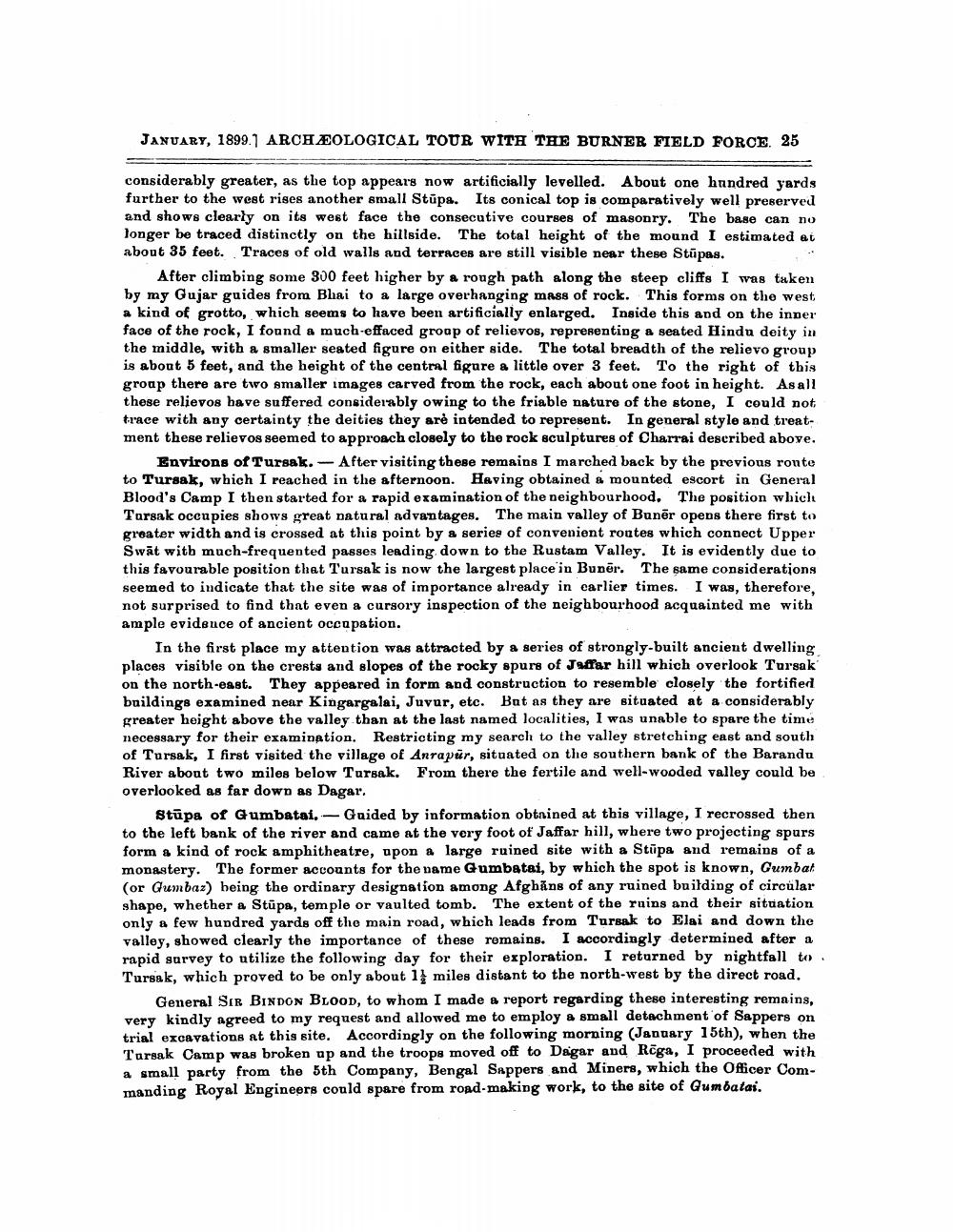________________
JANUARY, 1899.7 ARCHÆOLOGICAL TOUR WITH THE BURNER FIELD FORCE. 25
considerably greater, as the top appears now artificially levelled. About one hundred yards further to the west rises another small Stúpa. Its conical top is comparatively well preserved and shows clearly on its west face the consecutive courses of masonry. The base can no longer be traced distinctly on the hillside. The total height of the mound I estimated at about 35 feet. Traces of old walls and terraces are still visible near these Stūpas.
After climbing some 300 feet higher by a rough path along the steep cliffs I was taken by my Gujar guides from Blai to a large overhanging mass of rock. This forms on the west a kind of grotto, which seems to have been artificially enlarged. Inside this and on the inner face of the rock, I found a much-effaced group of relievos, representing a seated Hindu deity in the middle, with a smaller seated figure on either side. The total breadth of the relievo group is about 5 feet, and the height of the central figure a little over 3 feet. To the right of this groap there are two smaller images carved from the rock, each about one foot in height. As all these relievos have suffered considerably owing to the friable nature of the stone, I could not trace with any certainty the deities they are intended to represent. In general style and treatment these relievos seemed to approach closely to the rock sculptures of Charrai described above.
Environs of Tursak.- After visiting these remains I marched back by the previous route to Tursak, which I reached in the afternoon. Having obtained a mounted escort in General Blood's Camp I then started for a rapid examination of the neighbourhood. The position which Tarsak occupies shows great natural advantages. The main valley of Bunēr opens there first to greater width and is crossed at this point by a series of convenient routes which connect Upper Swāt with much-frequented passes leading down to the Rustam Valley. It is evidently due to this favourable position that Tursak is now the largest place in Bunēr. The same considerations seemed to indicate that the site was of importance already in earlier times. I was, therefore, not surprised to find that even a cursory inspection of the neighbourhood acquainted me with ample evidence of ancient occupation.
In the first place my attention was attracted by a series of strongly built ancient dwelling places visible on the crests and slopes of the rocky spurs of Jaffar hill which overlook Tursak on the north-east. They appeared in form and construction to resemble closely the fortified buildings examined near Kingargalai, Juvur, etc. But as they are situated at a considerably greater height above the valley than at the last named localities, I was unable to spare the time necessary for their examination. Restricting my search to the valley stretching east and south of Tursak, I first visited the village of Anra pür, situated on the southern bank of the Barandu River about two miles below Tursak. From there the fertile and well-wooded valley could be overlooked as far down as Dagar.
Stupa of Gumbatai. - Guided by information obtained at this village, I recrossed then to the left bank of the river and came at the very foot of Jaffar hill, where two projecting spars form a kind of rock amphitheatre, upon a large ruined site with a Stupa and remains of a monastery. The former accounts for the name Gumbatai, by which the spot is known, Gumbat (or Gumbaz) being the ordinary designation among Afgbảns of any ruined building of circular shape, whether a Stupa, temple or vaulted tomb. The extent of the rains and their situation only a few hundred yards off the main road, which leads from Tursak to Elai and down the valley, showed clearly the importance of these remains. I accordingly determined after a rapid survey to utilize the following day for their exploration. I returned by nightfall to Tursak, which proved to be only about 1 miles distant to the north-west by the direct road.
General Sir BINDON BLOOD, to whom I made a report regarding these interesting remains, very kindly agreed to my request and allowed me to employ a small detachment of Sappers on trial excavations at this site. Accordingly on the following morning (January 15th), when the Tarsak Camp was broken up and the troops moved off to Dagar and Rēga, I proceeded with a small party from the 5th Company, Bengal Sappers and Miners, which the Officer Commanding Royal Engineers could spare from road-making work, to the site of Gumbatai.




